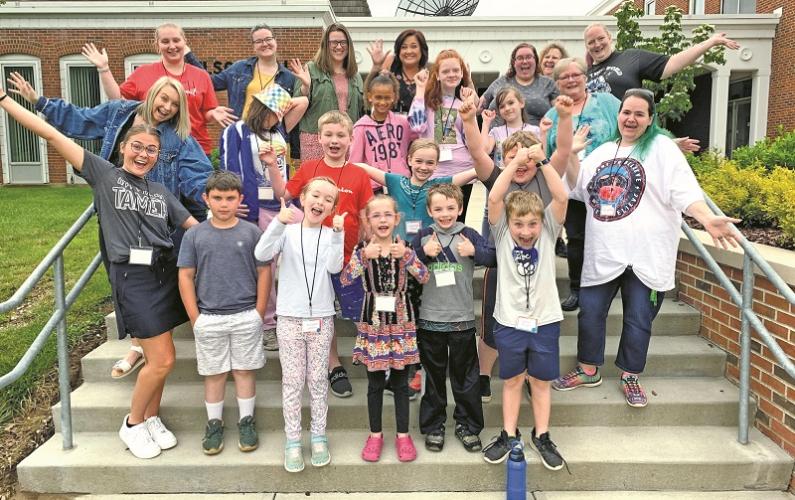
Professional development camp embeds educators in the STREAM

“Often you go to professional development, somebody talks at you for a few hours, and you leave,” said Ohio University Zanesville’s Dr. Teri Peasley, program coordinator for early childhood and elementary education. She and Dr. Theresa Paterra, education program assistant, decided it was up to them to create a more meaningful experience for teachers.
Utilizing funding opportunities from OHIO Regional Higher Education’s Workforce Success Initiative, they created a professional development opportunity in the form of a STREAM Camp for Professional Educators in summer 2022.
“We brought in local educators who teach third, fourth and fifth grade and taught them what it means to teach and embed STREAM concepts in daily course content – which is a little bit of a switch sometimes for people to go from very curriculum-based, ‘I must do this, I must achieve this,’ to a more hands-on approach with their students,” said Peasley.
During this two-week camp, teachers developed and delivered engaging curriculum for students in STREAM content (science, technology, reading/writing, engineering, art and mathematics), while positioning students for success in adulthood.
The standards-based lesson plans created by teachers focused on aerospace and meteorology, two concepts that are frequently taught in third to fifth grades.
“They had to build content, build a lesson plan, figure out how to fill two and a half hours of time with children they’ve never met – and make it relevant for everybody,” said Peasley.
Teachers went through self-assessments to gauge their own understanding of the concepts and then were able to work with materials such as film canisters, Styrofoam trays, tape and other simple materials to experience STREAM content for themselves during the first week of the camp. This allowed them to utilize the “learn, practice, apply” educational strategy throughout the course of the camp.
“Experiential learning is something in education, in some factions, we’ve gotten away from because we are so busy making sure that students can achieve the goals of a standardized test,” said Peasley. And experiential learning is important because it “helps the learning stick. When we move and create, we don’t forget what we’ve done. It’s good for teachers to have those experiences themselves, because we get back to our childhood selves and remember that learning is fun and it doesn’t have to be boring. Experiential learning for teachers helps them to be experiential educators.”
After educators built their curriculum, including three aerospace activities and three meteorology activities, they shared the newly created content with each other. This led to deep, engaging conversation about the challenges they experienced in their classrooms, as well as their successes, said Peasley.
The second week of the camp, the children arrived
“Seeing these truly engaged young children in the dead of the summer – school is the last thing on their minds. It really became very play-based, which is so important for young learners,” said Peasley.
On the final day of the camp, the children were introduced to the story of Caine Monroy, a child who created an arcade from discarded cardboard and tape in his father’s auto parts store. His creation, dubbed Caine’s Arcade, spurred challenges across the globe to build working creations out of cardboard. The STREAM campers participated in this challenge.
“It’s a really neat experience for children who are used to having high tech and everything at their fingertips to go back to the roots of childhood and literally create something with boxes and tape,” said Peasley
The campers shared their work on stage in an auditorium in front of their parents, camp leaders and peers.
“Each child got to hold the microphone and, with a ton of confidence, shared exactly what they had done and why,” said Peasley. “We got to engage the families, the teachers were proud, the students were prouder.”
According to Peasley, the STREAM Camp was a success for both student learning creativity and inspiring teachers to take these ideas back into their classrooms. And the successes and learning didn’t stop there.
Peasley and Paterra recently had an opportunity to present their STREAM Camp at the Ohio Educational Technology Conference and share with administrators and professional development coordinators from across the state, and Paterra is contributing a chapter to “Motivation and Momentum in Adult Online Education” to share her strategies for teaching future educators about K-12 STREAM education.
Peasley is also continuing to collaborate with her community, as she was approached by a Head Start program and asked to create a STEM training for preschool teachers. Peasley used many of the same materials for the preschool STEM training as she did in the STREAM Camp, but adapted them for a younger audience.
“I had 30 people who were down on the floor and playing and learning,” she said of her new trainees.
Paterra also shared her skills with the community, preparing programming for Sycamore Youth Center’s K-12 summer camp.
Regional Higher Education Workforce Success Initiative funding creates opportunities
As for her colleagues who may be considering applying for Regional Higher Education Workforce Success Initiative funding, Peasley says they should take advantage of the opportunity.
“Don’t be afraid to take a risk and think outside of the box for something that would support the workforce across any discipline” Peasley said. She noted that the Appalachian region will soon see growth across all sectors due to Intel’s plans to build in the area. “We know that and we are in a position to do something about it, and to support the people in our community.”
To learn more about the RHE Workforce Success Initiative, or to apply for funding, visit https://www.ohio.edu/regional/faculty-and-staff-resources/workforce-success-initiative.
